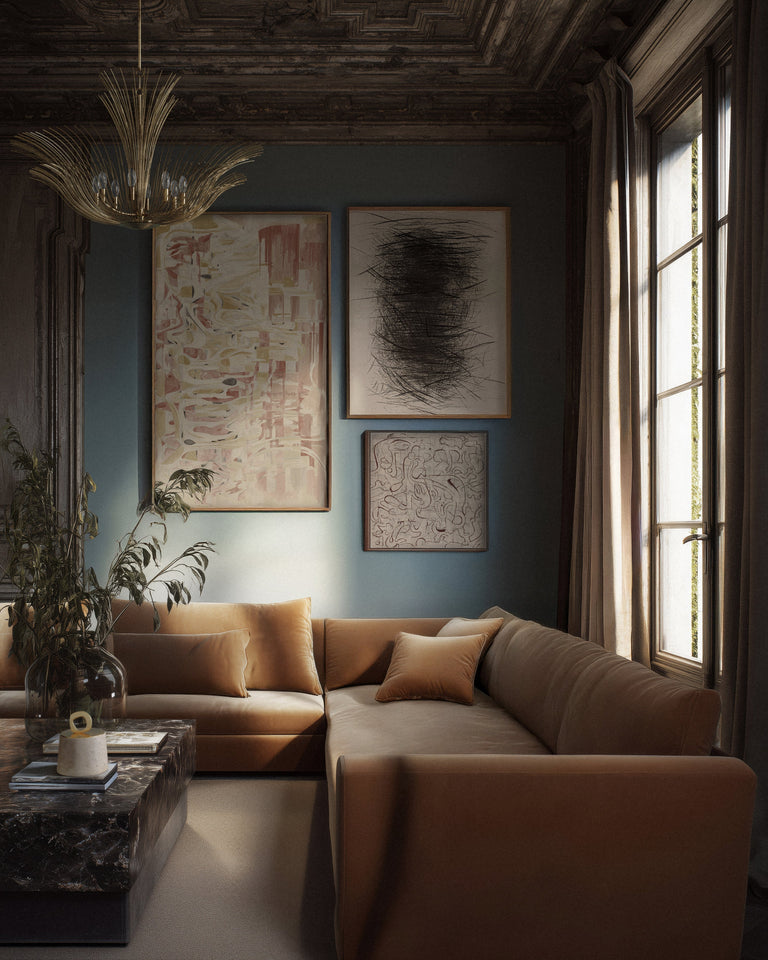
The Evolution of Minimalism
Few movements have proven as permanent in modern day design as minimalism. What began as a revolutionary rejection of ornamental excess has evolved into design's most sophisticated and timeless language, one that speaks as clearly to contemporary life as it did to the modernist pioneers nearly a century ago.
This evolution reveals minimalism’s greatest strength: its ability to transcend trends and speak to our fundamental need for clarity, function, and spatial order. But in stripping back to the essentials, have we also stripped away a deeper meaning?
Foundations: Where Minimalism Was Born
To understand minimalism's enduring power, we must return to its philosophical origins in early 20th-century Europe, where a convergence of artistic movements laid the groundwork for what would become design's most lasting language.
The Bauhaus Revolution: Function as Beauty
In 1919, Walter Gropius founded the Bauhaus school in Weimar, Germany, establishing principles that would fundamentally reshape our understanding of design. The Bauhaus wasn't merely an art school, as it was a revolutionary philosophy, rejecting the artificial divide between fine and applied arts, between beauty and utility.
Gropius and his colleagues, including Marcel Breuer, Ludwig Mies van der Rohe, and László Moholy-Nagy, proposed a radical point of view: the highest form of beauty emerges from perfect alignment between form and function. Thus, distilling objects to their most essential expression.
It’s no surprise, then, that Mies van der Rohe’s famous dictum “less is more” was a revelation at the time. His Barcelona Chair (1929) showed how reduction could elevate rather than diminish a timeless design. Every element served multiple purposes: the X-frame provided both support and visual elegance, the leather upholstery offered comfort while maintaining clean lines, and the overall proportions achieved a perfect balance between presence and restraint.

The Masters of Essential Form: Building on History
Within this rich historical context, three designers emerged who would prove crucial to minimalism's continued evolution and enduring relevance.
Vladimir Kagan: Sculpture Meets Comfort
Vladimir Kagan revolutionized mid-century design by proving that sculptural beauty and human comfort need not be mutually exclusive. Drawing on both Bauhaus principles and biomorphic surrealism, his serpentine sofas and organic forms demonstrated minimalism could be sensual, and an absence of ornament does not equate to the absence of soul.
Kagan's genius lay in his understanding that timeless design serves the body as well as the eye - pieces that invited touch, encouraged gathering, and supported the rituals of modern living. His work showed how minimalist principles could evolve to embrace more organic, fluid forms while maintaining conceptual rigor.
Image courtesy of Vladimir Kagan Official
Jean Royère: European Sophistication
Jean Royère brought a distinctly European sensibility to minimalist thinking, proving that restraint could coexist with warmth and luxury. His "Polar Bear" sofa and sculptural seating challenged the notion that minimal meant cold or austere.
Working in post-war Paris, Royère understood lasting design required emotional resonance, much different than those on display at international design fairs. His work demonstrated minimalism ability to welcome sophistication, a balance between restraint and ornament which remains relevant today.

Royère Polar Bear Sofa | Ours Polaire Sofa courtesy of Royère
Isamu Noguchi: The Eternal and Essential
Noguchi perhaps more than any other designer embodied minimalism's timeless potential. His coffee table, now an icon of enduring modern design, proved essential form could be both sculptural and functional.
Drawing on his background in sculpture and his understanding of both Eastern and Western aesthetic traditions, Noguchi crafted furniture which transcended categorization. His pieces won praise in galleries and lived well in residential spaces, proving the highest minimalist design serves both artistic and practical needs.

Freeform Sofa by Isamu Noguchi, 1946 courtesy of Vitra
Contemporary Influences: How History Shapes Today
Understanding this rich historical lineage helps us recognize how minimalist principles continue to evolve and influence contemporary design. Today's most compelling minimalist furniture build on the philosophical foundations established by these pioneers while addressing what is current.
In our increasingly complex digital world, minimalist design provides what it always has: clarity, focus, and calm. Contemporary minimalist furniture serves as an antidote to digital overwhelm, offering spaces for contemplation, genuine human connection and sustainable living.
Introducing the Rulmann Collection
Within this context of minimalism's ongoing evolution, we present the Rulmann Collection, a comprehensive seating system designed to honor the legacy of minimalist masters while uplifting a conversation on timeless design.
The Rulmann Swivel Chair: Motion as Eternal Poetry
The Rulmann Swivel Chair embodies the collection's commitment to timeless organic modernism translated into singular, sculptural seating. Drawing inspiration from the fluid movement studies of Kagan, the sophisticated restraint of Royère, and Noguchi's understanding of sculptural form, this chair transforms the concept of swivel seating into something approaching permanent sculpture.
With its grounded base and fluid 360° movement, the Rulmann Swivel demonstrates how motion and form can coalesce into furniture that transcends temporal limitations.
The Rulmann Sofa: Comfort Across Generations
The sofa's modular sensibility reflects our understanding that timeless design must be adaptable. Like the best minimalist traditions, from Breuer's modular furniture systems to the Eames' stackable chairs, it anchors space while allowing for personal interpretation and evolution.
The Rulmann Modular Sectional: Flexibility Within Timeless Form
Perhaps no piece in the collection better embodies the ongoing evolution of minimalism than the Rulmann Modular Sectional. Here, the principles of essential form, first articulated in the workshops of the Bauhaus and refined through decades of practice, meet the reality of how people live today. Designed for a flexible, communal lifestyle.
The Enduring Promise of Minimalism
The collection demonstrates that the highest form of minimalist design is grounded in permanence. Minimalism's greatest achievement is the enduring forms and principles we know and adore today. In a world where change is the only constant, good minimalist design offers something precious: human comfort is paramount.
The Timeless Future
The Rulmann Collection offers some respite to an ongoing discussion which began in the workshops of the Bauhaus: what makes design timeless?
The answer lies in the principles which have guided minimalism's greatest practitioners across nearly a century of evolution: honest materials, perfect proportions, and forms which serve both practical and emotional needs with equal grace.
Lemieux et Cie honors these traditions through our Rulmann collection, designing furniture to fulfill an innate human desire for beauty in daily life.
Discover the complete Rulmann Collection, where minimalism's century-long evolution meets contemporary craft. Each piece represents our commitment to furniture that serves not just the moment, but the eternal human appreciation for essential beauty.
Recent Edits








